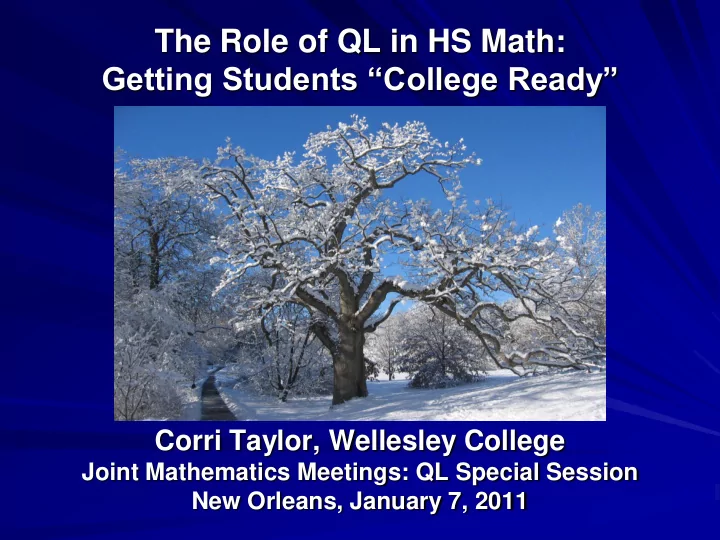

The Role of QL in HS Math: Getting Students “College Ready” Corri Taylor, Wellesley College Joint Mathematics Meetings: QL Special Session New Orleans, January 7, 2011
Drawing lessons from QR at colleges & universities
And from working with secondary school teachers in VA, MA
MAA’s QR Competencies Reading and understanding quantitative info in graphs, tables, etc. Interpreting quantitative info and drawing appropriate inferences Solving problems using logic, math, statistics Estimating answers and checking for reasonableness Communicating quantitative info – verbally, graphically, numerically Recognizing the limitations of mathematical or statistical models
At college students need to connect math & contexts In science and social science courses, esp. With math in real world contexts, the problem- solving process is authentic. It starts earlier with the framing of the question, spelling out key assumptions, assessing available data, etc. It also goes further than the basic “math textbook problem” requiring good interpretation and communication about the results. Several college-level QR programs (e.g., Wellesley, Hollins University) focus on authentic problems and on analysis of data.
…and from the other direction, they must connect contexts and math Instead of thinking of QR as math plus context and communication…. We can think of QR as context and communication enhanced by quantitative evidence. Carleton College frames QR as it relates to rhetoric…. focuses on how QR is used in the construction and evaluation of arguments
NCTM’s 2009 Publications & CCSSM’s Math Practices More of a QR approach present in mainstream K-12 math today than 10 years ago Reasoning – process of drawing conclusions on basis of evidence or stated assumptions Sense-making – developing understanding of a situation, context, or concept by connecting it with existing knowledge Constructing viable arguments
Secondary School Teachers Need Help Integrating a QR Approach At middle and h.s. levels, math is often compartmentalized, disconnected Math teachers show interest in QR but need professional development – guidance toward good resources; time to make assignments that are engaging to students at their level
“Only Connect…” Focus on connections offered by a QR approach Integrated learning Results: more motivated students, better conceptual understanding, better retention (of info and of students), college and career ready
Fostering a Conspiracy QR is important at all levels of education: elementary, secondary, college In all disciplines In school, work, life…. So let’s take up Deborah Hughes - Hallett’s 2007 challenge and "foster a conspiracy" in which faculty in all divisions repeatedly challenge students to apply QR in various contexts, develop QR as a “habit of mind” Let’s get more cooperation between K -12 and college/university faculty
How do we do this? Corri’s 5 tips on QR pedagogy Go deep. See the forest for the trees. Keep it real. Let them get “stuck.” Break down walls.
1. Go Deep One theme, one good table, one problem can address multiple mathematical topics Examples: tables from Census, from Statistical Abstract ; Fermi puzzles Take time to pursue!
2. See forest for the trees Focus on big picture: Example: relationship among fractions, decimals, percents, ratios Eric Gaze’s column on the NNN Web site
3. Keep it real At any level of education, there are real world examples of interest: data on the kids themselves; on personal finance… Real world is ALL word problems, so frame math questions authentically to start
4. Let them get stuck Not always, but sometimes Teach the math “just in time” Example: at what time do two exponentially growing towns have the same pop’n size? Avoids: When will I ever need this math?!
5. Break down walls Between math subject areas…e.g., between arithmetic & algebra Between math and quant. disciplines Use a team approach to best educate the student – to foster those connections
To help advance the conspiracy AMS Sectional, April 9-10, Holy Cross, “New Trends in College & University Faculty Engagement in K- 12 Education” NNN – Web site for various resources; Journal Numeracy for articles. Join us – help w/ our efforts to expand PD on QR. We encourage your submissions to our journal, too!
Recommend
More recommend